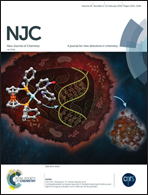A comparison of optical, electrochemical and self-assembling properties of two structural isomers based on 1,6- and 1,8-pyrenedione chromophores†
Abstract
Two isomeric donor–acceptor–donor (DAD) pyrene chromophores were synthesized and their optical, electrochemical and solid-state properties were investigated. Both chromophores showed similar light absorption profiles that spanned the visible region from 300 nm to 800 nm, in part due to strong intramolecular charge transfer bands. Both 1,6- and 1,8-pyrenediketone acceptor cores exhibited similar reversible electrochemical reductions at potentials of −0.91 V and −0.86 V versus ferrocene/ferrocenium, respectively, which yields approximate LUMO energy levels of −3.9 eV versus vacuum. By design, both DAD chromophores displayed both electro- and halochromism. Despite their similar structure, only the 1,6-pyrenediketone derivative exhibited self-assembly in the solid-state by forming a soft crystalline phase. Furthermore, the solid-state film absorption profile of the 1,6-pyrenediketone isomer showed a significant change in the absorption profile upon annealing above its cold-crystallisation temperature, providing an absorption band that extends to 900 nm, suggesting strong intermolecular electronic interactions.



 Please wait while we load your content...
Please wait while we load your content...